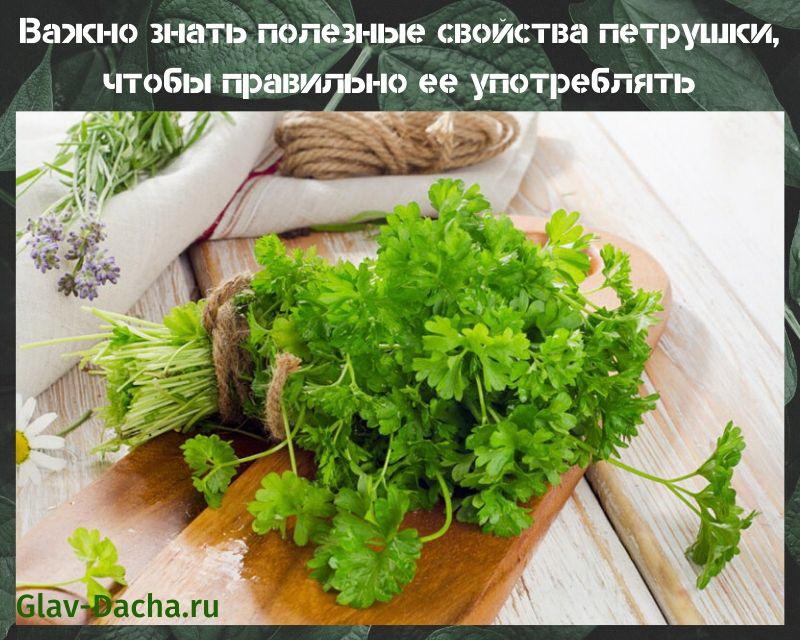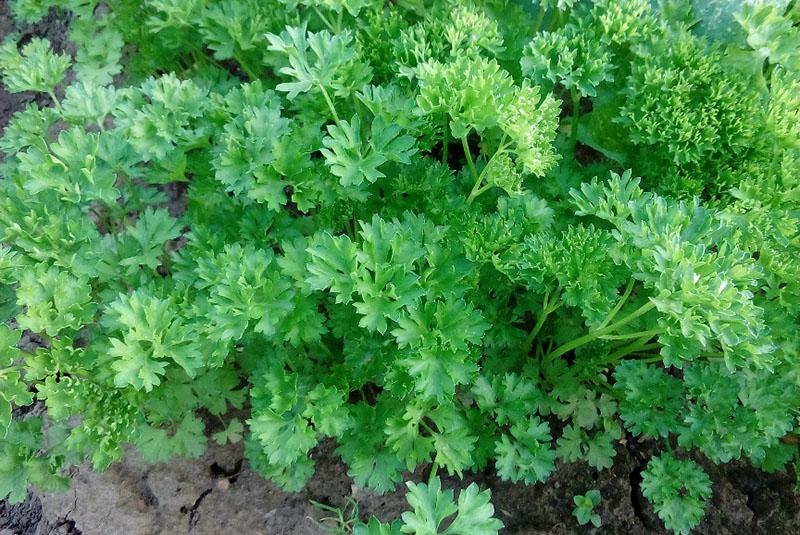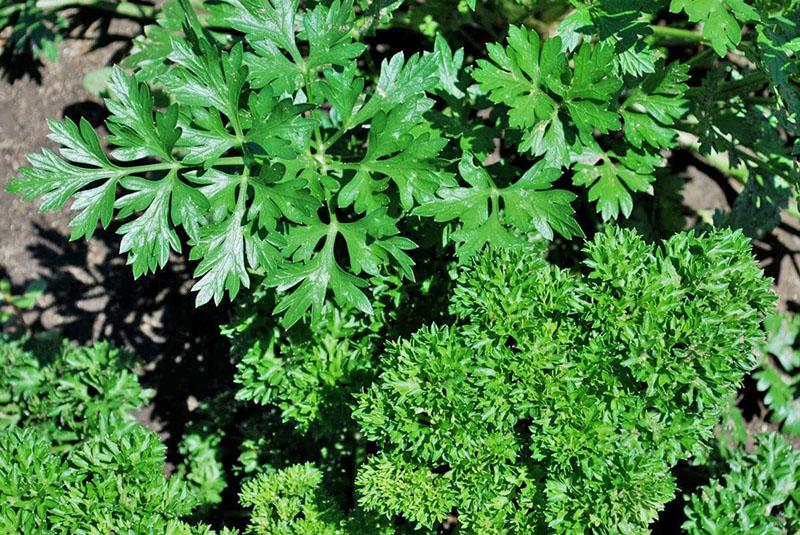It is important to know the beneficial properties of parsley in order to use it correctly
 The beneficial properties of parsley are due to the rich chemical composition of the plant. It is widely used as a kind of vitamin supplement to soups, salads and main courses. Parsley is also known as an excellent means of rejuvenation and has long been used in cosmetology. However, it has a number of serious contraindications.
The beneficial properties of parsley are due to the rich chemical composition of the plant. It is widely used as a kind of vitamin supplement to soups, salads and main courses. Parsley is also known as an excellent means of rejuvenation and has long been used in cosmetology. However, it has a number of serious contraindications.
Biological description of the plant

The plant begins to bloom in mid-June. Flowers are small, yellow-green in color. The fruit is oval in shape and brown.
Parsley is cultivated all over the world. In different countries, it is actively used as a seasoning. In addition to cooking, the plant is valued in medicine and cosmetology.
Parsley has a spicy taste and a pronounced herbal aroma. Small inflorescences of yellow-green flowers form on thin branches, after which dark ovoid seeds form.
Parsley varieties
 Once upon a time, this herb was considered decorative and only from the 15th century it began to be actively used for food. Now known varieties and hybrids, bred by breeders with differences in aroma and taste.
Once upon a time, this herb was considered decorative and only from the 15th century it began to be actively used for food. Now known varieties and hybrids, bred by breeders with differences in aroma and taste.
Parsley is divided into root varieties and leafy varieties. Have root parsley the rhizome, which is used in cooking and medicine, is valued. Leafy is grown to obtain juicy healthy greens.
The most common varieties include:
- leafy sandwich - large leaves with good taste;

- productive - mid-season variety, grown for useful root crops;

- Bravo - the greens are very lush with a good aroma and taste;

- The Italian giant has large and shiny leaves, but the roots are not used for food;

- Titanium is an early variety valued for its frost resistance.

Parsley, due to its beneficial properties, has an effect on the entire body and is recommended by nutritionists for daily use.
 The distribution area of wild parsley is most of the Mediterranean countries. The plant is cultivated in continental Europe, in some areas of Canada, in the north of the United States. In Russia, parsley is grown in the country's temperate climate, as well as in the south of the Far East and Siberia. Leafy parsley is actively cultivated in the northern regions, since the growing season is short.
The distribution area of wild parsley is most of the Mediterranean countries. The plant is cultivated in continental Europe, in some areas of Canada, in the north of the United States. In Russia, parsley is grown in the country's temperate climate, as well as in the south of the Far East and Siberia. Leafy parsley is actively cultivated in the northern regions, since the growing season is short.
Nutritional value and chemical composition of the plant
 The calorie content of parsley is no more than 47 kcal, so it is considered a dietary product. However, nutritionists claim that the spice is a negative calorie product, since the body spends much more calories on digestion than it receives.
The calorie content of parsley is no more than 47 kcal, so it is considered a dietary product. However, nutritionists claim that the spice is a negative calorie product, since the body spends much more calories on digestion than it receives.
In addition, in 100 g of the product:
- proteins - 4.5 g;
- fat - 0.4 g;
- carbohydrates - 7.2 g
If you add parsley to your food every day, you can get a huge amount of vitamins and minerals. Among them are the following elements:
- B vitamins;
- retinol (vitamin A);
- tocopherol (vitamin E);
- vitamin K;
- ascorbic and folic acids.
Of the minerals, parsley is rich in potassium, calcium, magnesium, phosphorus, sodium, as well as iron and zinc.Each of these components is of great importance for the body and helps to carry out important functions in organs and tissues.
Medicinal and beneficial properties of parsley
 The beneficial properties of parsley are due to the rich chemical composition of the plant.
The beneficial properties of parsley are due to the rich chemical composition of the plant.
Daily use of the product has a beneficial effect on the entire body as a whole:
- strengthens the immune system;
- suppresses the effect of pathogenic microorganisms;
- normalizes metabolic processes in the body;
- restores hormones;
- prevents the development of many cardiovascular pathologies;
- stabilizes blood pressure;
- helps to eliminate toxins and carcinogens;
- protects liver cells;
- prevents calcium leaching;
- improves many processes in the body, such as digestion and urination.
 In addition, the vitamins and minerals in parsley have a positive effect on the nervous system, reduce stress levels, help cope with depression, and also have a beneficial effect on the skin, mucous membranes, bone tissue and organs of vision.
In addition, the vitamins and minerals in parsley have a positive effect on the nervous system, reduce stress levels, help cope with depression, and also have a beneficial effect on the skin, mucous membranes, bone tissue and organs of vision.
It is important to keep in mind that not only the parsley leaf plate has beneficial properties, but also the rest of the plant.
Herbalists use the root of the plant, which has anti-inflammatory and antiseptic effects. Oily seeds are also in demand in medical practice.
Benefits of parsley for men

For men, parsley will help in solving the following problems:
- prostatitis;
- restoration of potency;
- cleansing of toxins;
- relief from nicotine and alcohol addiction;
- strengthening of the heart tone.
To solve these problems, you need to eat fresh parsley or daily use of decoctions.
Useful properties for women

Daily consumption of parsley is also necessary for the female body:
- reduction of menstrual pain;
- solving problems with cellulite;
- strengthening hair.
Women use parsley to refresh their face and fight premature wrinkles.
Useful properties of parsley for children
 Before using parsley as a remedy for children, you will need to consult a pediatrician.
Before using parsley as a remedy for children, you will need to consult a pediatrician.
Often the plant helps with the following pathologies:
- enhances immunity;
- disinfects wounds and treats the consequences of bruises;
- improves the functioning of the intestines and stomach;
- raises the level of hemoglobin in the blood.
Parsley also helps to restore the baby's nervous system and improve sleep.
Contraindications and restrictions
 Despite all the useful and medicinal properties of parsley, like any other plant, it has a number of very serious contraindications and restrictions.
Despite all the useful and medicinal properties of parsley, like any other plant, it has a number of very serious contraindications and restrictions.
Do not overuse parsley during pregnancy, especially in the later stages, since uncontrolled use of the product can cause miscarriage and premature birth.
In addition to pregnant and lactating women, restrictions are provided for infants, people prone to allergies, as well as for patients with certain chronic diseases. However, it should be understood that in small quantities, parsley is very useful in any condition, and in no case should you completely abandon it. For example, in reasonable quantities, the plant increases lactation in lactating women, so it is important to maintain a certain balance, and at the same time not to ignore other healthy foods.
Contraindications include:
- pathology of the genitourinary sphere in the acute stage;
- acute forms of gastrointestinal diseases;
- epilepsy;
- disorders of calcium absorption;
- allergy to plant components;
- cholelithiasis.
If the patient plans to treat with the roots or green mass of parsley, then you should notify your doctor and receive the necessary recommendations from him.
Dangerous properties of parsley
Any plant can be very dangerous to health if you use low-quality raw materials and do not control the amount when consumed.For medicinal purposes, you will need raw materials grown in ecologically clean areas, in compliance with all the necessary standards. You should not eat and even more so be treated with a plant that has a dubious origin. In addition, it is important to soak the parsley before use in order to rid it of any possible toxic impurities.
But the greatest danger to the body lies in the use of medicines based on parsley seeds. They contain essential oils, which include apiol and myristicin, and these substances are quite toxic when taken orally. In case of an overdose, these components can cause vomiting, nausea, seizures, headaches, and agitation of the nervous system.
Application of parsley
Besides the fact that parsley is actively used in cooking, it is popular among cosmetologists and herbalists. In this case, you can use all parts of the plant, according to recipes. Separately, it should be noted the use of parsley juice for weight loss.
Cooking use
 The leaves of the plant are added to fresh food, the stem is too dense and tough, it can give a little bitterness in salads, but it is quite suitable in soups and main courses. In addition to the leaves and stems, parsley root is also appropriate in soups. As a rule, it is added 10 minutes before the end of cooking.
The leaves of the plant are added to fresh food, the stem is too dense and tough, it can give a little bitterness in salads, but it is quite suitable in soups and main courses. In addition to the leaves and stems, parsley root is also appropriate in soups. As a rule, it is added 10 minutes before the end of cooking.
You can replace the spice cilantro - a plant that looks a lot like parsley. However, it has a richer taste and aroma, but in terms of useful properties it is in no way inferior to parsley.
They attach great importance to the use of greens in cooking, since with their help you can quickly enrich the dish with the maximum amount of vitamins, as well as decorate it. Parsley goes well with salads, meat and fish dishes, vegetables and cereals. It is appropriate in sauces, borscht and goulash. The only exception is desserts. Parsley root is also used, adding it dried or fresh.
As for the seeds of the plant, they are added to homemade preparations, preserving tomatoes, cucumbers, zucchini and eggplants with bell peppers for the winter.
Parsley is one of those herbs that do not lose useful minerals and vitamins during heat treatment. The only exception is ascorbic acid, which is always sensitive to the slightest increase in temperature. However, it is best to add the greens at the very end of cooking, keeping their beneficial qualities and flavor intact.
Use in cosmetology
 Parsley has extensive indications for the treatment of certain cosmetic defects. Lotions, creams, masks are made on its basis. The plant has a positive effect not only on the skin, but also on the quality of the hair.
Parsley has extensive indications for the treatment of certain cosmetic defects. Lotions, creams, masks are made on its basis. The plant has a positive effect not only on the skin, but also on the quality of the hair.
With the help of parsley, cosmetologists are successfully fighting the following problems:
- acne;
- pigmentation, freckles;
- expression and age wrinkles;
- excessive swelling;
- tired skin;
- dark circles under the eyes;
- greasy shine;
- dry skin.
Parsley root, along with leaf juice, is great for hair problems. The plant copes with dull, lifeless hair, as well as weak activity of the hair follicles.
Even if the skin on the face is young and healthy, rubbing it in the morning with an ice cube with a decoction of parsley will never be superfluous. So the integuments will be enriched with vitamins and other useful components.
Some caution is needed before applying cosmetics. After preparing the composition, you need to apply it on the wrist, and then it can be used only if there are no allergic rashes on the skin.
Masks and other face products made with parsley yourself should be used immediately after preparation. Ice cubes should be stored in the refrigerator for no more than 1 week, infusion, broth, juice - for a maximum of 3 days.You can use such cosmetics as needed, but not more often than 2 times a week masks, once every two days compresses for the eyelids. You can wash your face with an ice cube with parsley every morning.
For the preparation of cosmetics, a regular variety of parsley is suitable, do not use curly ones. Greens need to be chopped with a sharp knife, cutting as small as possible, or use a blender for these purposes. Dried parsley is also suitable for cosmetics, but one must bear in mind that it contains several times less vitamins than fresh parsley. From it you can make decoctions for washing or freeze ice.
The results of the effects of parsley on the skin of the face can be seen after a few days, but it is better not to stop there and carry out the full course of treatment.
Medical use

The indications for the treatment of parsley include many diseases. Among them:
- some pathologies of the stomach and intestines;
- alcoholism;
- urolithiasis disease;
- tumors;
- joint diseases;
- prostatitis;
- violation of the menstrual cycle;
- obesity;
- swelling;
- diseases of the heart and blood vessels;
- some infectious diseases;
- neuroses;
- cholelithiasis.
Parsley is often used as an additional remedy in the treatment of many pathologies. It has established itself as a hemostatic, anti-inflammatory, wound healing, analgesic and bactericidal agent. Those who decide to use this herb as a medicine should be aware of its indications and contraindications.
The plant sap is used for pathologies of the genitourinary sphere - cystitis, stones in the kidneys and ureter, nephritis and excessive swelling. In addition, the juice can be used for diseases of the organs of vision: cataracts, ophthalmia, conjunctivitis, ulceration of the mucous membrane of the eye in various infections. The juice is good for painful menstruation and other cycle disorders. Compresses made from fresh parsley juice are used for bruises, insect bites, as well as a decoction from different parts of the plant.
A decoction or infusion of parsley is indicated for disorders of the digestive tract, edema of the heart, as well as prostatitis. They are also used as a diuretic, choleretic and antispasmodic agent. A decoction of the roots, seeds and leaves of parsley is useful for scarlet fever and measles.
100 g of parsley contains double the daily dose of ascorbic acid (4 times more than lemon), but it is quickly destroyed by heat. That is why it is recommended to use it fresh, adding it to salads.
Storing parsley
 Fresh parsley can last up to a week in the refrigerator. It must be thoroughly rinsed, dried and put into a plastic container. If you want to preserve a plant grown on your own on a site for the winter, you should freeze it.
Fresh parsley can last up to a week in the refrigerator. It must be thoroughly rinsed, dried and put into a plastic container. If you want to preserve a plant grown on your own on a site for the winter, you should freeze it.
This can be done in several ways:
- Distribute the washed, dried greens into small bundles, tie them with threads, place each in a plastic bag and put it in the freezer.
- Many people prefer to pre-cut and pack in bags, taking out small portions if necessary.
- To prepare portioned cubes, you need to finely chop the herbs, tamp the ice making container tightly, add water. Put the molds in the freezer, and after freezing, transfer them to a more suitable container or bag.
- Mashed parsley will require chopping with a blender. Then you can add a little of any vegetable oil to the mass and freeze it in the chamber in portion forms. Then put the resulting cubes in bags.
Root vegetables can also be stored in a similar way - cut into cubes or strips, grate and freeze.
Before adding frozen parsley into the dish, it does not need to be defrosted.
You can store fresh parsley by placing it as a bouquet, for example in a glass of water.It will remain on the table for a week, and in the refrigerator for up to 3 weeks.
Another way to preserve the plant for a long winter is to dry it. To do this, you need to rinse, sort out and let it dry out of excess moisture. Then you should spread the plant in a well-ventilated place until the leaf plate is completely dry. Then you need to grind the blanks with your hands and place them in a suitable container. You can store dried parsley for about a year. At the same time, the aroma and taste are noticeably reduced.